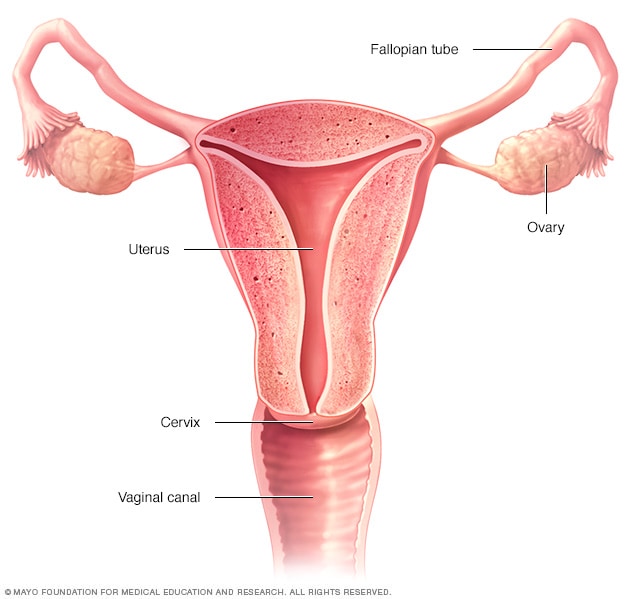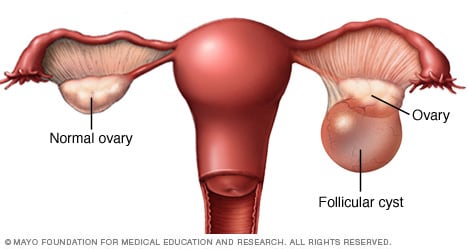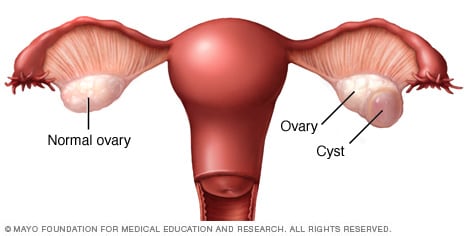Ovarian cysts
Ovarian cysts
overview
Female reproductive system

Female reproductive system
The ovaries, fallopian tubes, uterus, cervix and vagina (vaginal canal) make up the female reproductive system.
Ovarian cysts are fluid-filled sacs or pockets in an ovary or on its surface. Women have two ovaries - each the size and shape of an almond - on either side of the uterus. Oocytes (eggs), which develop and mature in the ovaries, are released in monthly cycles during childbearing age.
Many women have ovarian cysts at some point. Most ovarian cysts cause little or no discomfort and are harmless. The majority disappear without treatment within a few months.
However, ovarian cysts – especially those that have ruptured – can cause serious symptoms. To protect your health, get regular checkups and be aware of the symptoms that may indicate a potentially serious problem.
Symptoms
Most cysts cause no symptoms and go away on their own. However, a large ovarian cyst can cause:
- Beckenschmerzen – ein dumpfer oder scharfer Schmerz im Unterbauch auf der Seite der Zyste
- Völlegefühl oder Schweregefühl im Bauch
- Blähungen
When to go to the doctor?
Seek immediate medical attention if you have:
- Plötzliche, starke Bauch- oder Beckenschmerzen
- Schmerzen mit Fieber oder Erbrechen
If you have these signs and symptoms or those of shock - cold, clammy skin; rapid breathing; and drowsiness or weakness – seek medical attention immediately.
Causes
Follicular cyst

Follicular cyst
A follicular cyst occurs when the ovarian follicle fails to rupture or release its egg. Instead, it grows until it becomes a cyst.
Yellow body cyst

Yellow body cyst
Abnormal changes in the ovarian follicle after the release of an egg can cause the egg's exit opening to become closed. Fluid collects in the follicle and a corpus luteum cyst develops.
Most ovarian cysts develop as a result of your menstrual cycle (functional cysts). Other types of cysts are much rarer.
Functional cysts
Your ovaries normally form cyst-like structures called follicles every month. Follicles produce the hormones estrogen and progesterone and release an egg during ovulation.
When a normal monthly follicle continues to grow, it is called a functional cyst. There are two types of functional cysts:
- Follikuläre Zyste. Etwa in der Mitte Ihres Menstruationszyklus platzt ein Ei aus seinem Follikel und wandert den Eileiter hinunter. Eine follikuläre Zyste beginnt, wenn der Follikel nicht reißt oder sein Ei freisetzt, sondern weiter wächst.
- Gelbkörperzyste. Wenn ein Follikel sein Ei freisetzt, beginnt es mit der Produktion von Östrogen und Progesteron für die Empfängnis. Dieser Follikel wird jetzt Corpus luteum genannt. Manchmal sammelt sich Flüssigkeit im Follikel an, wodurch der Gelbkörper zu einer Zyste heranwächst.
Functional cysts are usually harmless, rarely cause pain, and often disappear on their own within two or three menstrual cycles.
Other cysts
Types of cysts that are not related to the normal functioning of your menstrual cycle include:
- Dermoidzysten. Auch Teratome genannt, können diese Gewebe wie Haare, Haut oder Zähne enthalten, da sie sich aus embryonalen Zellen bilden. Sie sind selten krebsartig.
- Zystadenome. Diese entwickeln sich auf der Oberfläche eines Eierstocks und können mit wässrigem oder schleimigem Material gefüllt sein.
- Endometriome. Diese entwickeln sich als Folge einer Erkrankung, bei der Gebärmutterschleimhautzellen außerhalb Ihrer Gebärmutter wachsen (Endometriose). Ein Teil des Gewebes kann sich an Ihren Eierstock anheften und ein Wachstum bilden.
Dermoid cysts and cystadenomas can become large and cause the ovary to move out of position. This increases the chance of a painful twisting of your ovary, called ovarian torsion. Torsion of the ovaries can also cause blood flow to the ovary to be reduced or stopped.
Video: Ovulation
View transcript
Ovulation is the release of an egg from one of the ovaries. It often happens around the middle of the menstrual cycle, although the exact timing can vary.
In preparation for ovulation, the uterine lining, or endometrium, thickens. The pituitary gland in the brain stimulates one of the ovaries to release an egg. The wall of the ovarian follicle tears at the surface of the ovary. The egg is released.
Finger-like structures called fimbriae sweep the egg into the neighboring oviduct. The egg travels through the oviduct, driven in part by contractions in the walls of the oviduct. Here in the fallopian tube the egg can be fertilized by a sperm.
When the egg is fertilized, the egg and sperm combine to form a single-celled unit called a zygote. As the zygote travels through the fallopian tube toward the uterus, it begins to divide rapidly, forming a cluster of cells called a blastocyst that resembles a tiny raspberry. When the blastocyst reaches the uterus, it implants into the uterine lining and pregnancy begins.
If the egg is not fertilized, it will simply be reabsorbed by the body - perhaps before it even reaches the uterus. About two weeks later, the uterine lining sheds through the vagina. This is called menstruation.
Risk factors
Your risk of developing an ovarian cyst is increased by:
- Hormonelle Probleme. Dazu gehört die Einnahme des Fruchtbarkeitsmedikaments Clomifen (Clomid), das verwendet wird, um den Eisprung auszulösen.
- Schwangerschaft. Manchmal bleibt die Zyste, die sich beim Eisprung bildet, während der gesamten Schwangerschaft an Ihrem Eierstock.
- Endometriose. Dieser Zustand führt dazu, dass Gebärmutterschleimhautzellen außerhalb Ihrer Gebärmutter wachsen. Ein Teil des Gewebes kann sich an Ihren Eierstock anheften und ein Wachstum bilden.
- Eine schwere Unterleibsinfektion. Wenn sich die Infektion auf die Eierstöcke ausbreitet, können Zysten entstehen.
- Eine frühere Ovarialzyste. Wenn Sie eine hatten, werden Sie wahrscheinlich mehr entwickeln.
Complications
Some women develop less common types of cysts that a doctor finds during a pelvic exam. Cystic ovarian masses that develop after menopause may be cancerous (malignant). That's why it's important to have regular gynecological exams.
Rare complications associated with ovarian cysts include:
- Eierstocktorsion. Zysten, die sich vergrößern, können dazu führen, dass sich der Eierstock bewegt, was die Wahrscheinlichkeit einer schmerzhaften Verdrehung Ihres Eierstocks (Ovarialtorsion) erhöht. Zu den Symptomen können ein plötzliches Einsetzen schwerer Beckenschmerzen, Übelkeit und Erbrechen gehören. Eine Torsion der Eierstöcke kann auch den Blutfluss zu den Eierstöcken verringern oder stoppen.
- Bruch. Eine platzende Zyste kann starke Schmerzen und innere Blutungen verursachen. Je größer die Zyste, desto größer das Risiko einer Ruptur. Starke Aktivitäten, die das Becken betreffen, wie z. B. Vaginalverkehr, erhöhen das Risiko ebenfalls.
prevention
Although there is no way to prevent ovarian cysts, regular pelvic exams will help diagnose changes in your ovaries as early as possible. Watch for changes in your menstrual cycle, including unusual menstrual symptoms, especially those that last longer than a few cycles. Talk to your doctor about any changes that worry you.
Sources:
- Häufig gestellte Fragen. Gynäkologische Probleme FAQ075. Eierstockzysten. American College of Geburtshelfer und Gynäkologen. http://www.acog.org/Patients/FAQs/Ovarian-Cysts. Abgerufen am 2. Mai 2017.
- Muto MG. Annäherung an den Patienten mit einer Adnexmasse. https://www.uptodate.com/contents/search. Abgerufen am 2. Mai 2017.
- Faktenblatt Ovarialzysten. Büro für Frauengesundheit, US-Gesundheitsministerium. http://www.womenshealth.gov/publications/our-publications/fact-sheet/ovarian-cysts.html. Abgerufen am 2. Mai 2017.
- Scharfes HT. Bewertung und Behandlung von rupturierten Ovarialzysten. https://www.uptodate.com/contents/search. Abgerufen am 2. Mai 2017.
- Muto MG. Management der Adnexmasse. https://www.uptodate.com/contents/search. Abgerufen am 20. August 2020.

 Suche
Suche
 Mein Konto
Mein Konto